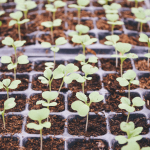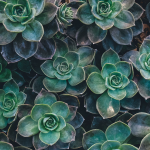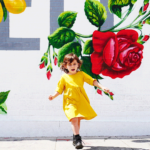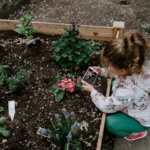
02 Apr Sensory Gardens
A sensory environment has many benefits and promotes inclusion for all children, including those with a disability or mental illness.
A two year old can actively experience the garden, while babies can enjoy the stimulation of changes in light and shadows, colours and movement, fragrant smells, the many sounds, and the sensation of the sun’s warmth or air moving on the skin.
Children can also spend time with other adults and children, which creates an opportunity for developing social skills and learning about the natural world.
Opportunities for hand/eye and motor skills development can also be found by walking on different surfaces such as fallen leaves that rustle when stepped on, promoting balance and gait development.
Generally, learning by doing generates lasting impressions. Active gardening can also help children burn energy.
ASPECT, an organisation that provides support services for children with autism spectrum disorder, encourages gardening as a way of facilitating behaviour management, since energy is directed into physical activities.
Here are some ways to promote sensory aspects of your garden.
Visual attributes: colour, contrast, luminosity, form and shape.
Colour can be used to create the mood of your garden:
- Create contrast by using opposite colours on the colour wheel.
- Create harmony by using colours that are close on the colour wheel.
- Create temperature by choosing cool or warm colours.
It’s also important to look at plant foliage and barks.
Plants with interesting foliage colour include:
-
Acacias (dark green)
-
Grass (Poa, Festuca glauca, Stipa)
-
Cordylines (red, variegated)
-
Bromeliads (many colours)
-
Deciduous species, such as Melia and Acer
Shape and form
The shape of garden spaces, for example ‘linear’ or ‘curved’, can have an impact on how you move through the space. The shape of garden elements, including built structures such as paths, boundaries, garden beds and plants, all contribute to this.
Texture
- Eucalyptus
-
Crepe myrtle
-
Melaleuca (paperbark)
-
Succulents
Plants with interesting seed heads, pods and fruit:
- Casuarina
- Banksia serrata (old man banksia)
- Banksia robur (swamp banksia)
- Callistemon (bottlebrush)
- Pelargonium (geranium)
- Mosses
There are many edible ornamental plants, which are highly decorative as well as productive.
Taste
Examples include:
-
Herbs
-
Beetroot
-
Lettuces
-
Rhubarb
-
Shallots
-
Silverbeet
Many plants have aromatic scents. Herbs for scent are:
- Thyme
- Marjoram
- Mint
- Nasturtium
- Lavender
- Rosemary
Trees and shrubs for scent:
- Backhousia citriodora (lemon myrtle)
- Darwinia citriodora (lemon-scented leaves)
- Philotheca myoporoides (waxflower)
- Eucalyptus species, such as peppermints
- Leptospermum petersonii (lemon-scented leaves)
- Murraya paniculata (fragrant flowers)
- Pelargonium (many with scented foliage)
- Plumeria rubra (frangipani)
- Prostanthera (native mint bushes)
- Thryptomene saxicola
- Tulbaghia
- Viola odorata (violet)
Fauna attracting plants
Butterfly attracting plants include:
-
Austrodanthonia (wallaby grass)
-
Chrysocephalum (Helichrysum)
-
Lomandra
-
Poa
-
Stylidium graminifolium (trigger plant)
-
Themeda australis (kangaroo grass)
-
Xanthorrhoea (grass tree)
Birds are attracted to small leafed native plants, including:
- Acacia
- Callistemon
- Correa
- Grevillea
- Hakea
- Banskias
Suggestions for getting started:
- Begin with easy care plants and seek advice from local nurseries.
- Try planting species native to your area, as they are often well adapted to the climatic conditions.
- Avoid plants with thorns and toxic parts.
- Always consult a garden designer or your local nursery to assist with plant selection suitable for your climate, location and needs. Some species grown outside their natural habitat are considered noxious or environmental weeds. Consult your local council for information on weed species in your area.
This information was provided by Cultivate NSW.
Words by Felicity Roberts





